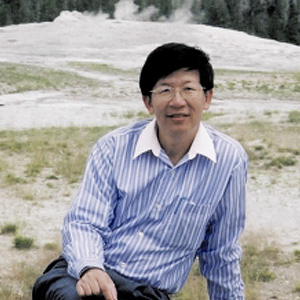 |
Name |
楊鴻昌
Hong-Chang Yang |
| Title |
Professor |
| Education |
Ph. D. ,Iowa State University(1983) |
| Office |
|
| Tel |
|
| E-mail |
|
| Web |
|
| Research |
Studies of device physics include high-Tc superconducting quantum interference device (SQUID), Josephson junctions, junction arrays, SQUID arrays, magnetometers and gradiometers SQUID Applications are focused on magnetocardiogram (MCG), nondestructive evaluation (NDE), nuclear magnetic resonance (NMR) and imaging (MRI), detection of magnetic bio-molecules, and scanning microscopy.
Other research interest are:
1.Superconducting filters and bolometers.
2.Physical properties of MgB2 films and SQUID devices.
3.Magneto-optical properties of magnetic fluid thin films.
4.Flux dynamics of (superconducting/magnetic) thin films with anti-dots.
5.Transport and thermoelectric properties of
(1)YBa2Cu3Oy/PrBa2Cu3-xAxOy superlattices, and
(2)YBa2Cu3Oy/R1-xMxMnO3 superlattices, in which R = La or Nd, M = Sr or Ca. |
| Selected Publications |
- H.H. Chen, Hong-Chan Yang, H.E. Horng, Y.Y. Lee, S.H. Liao, S.Y. Yang, C.H. Chou, L.J. Chang, M.J. Chen, M.Y. Chern, Phys. Rev. A 81, 033422-1-033422-6 (2010).
- Hong-Chang Yang*, Herng-Er Horng, S. Y. Yang and Shu-Hsien Liao, “Advances in biomagnetic research using high-Tc superconducting quantum interference devices”, Supercon. Sci. Technol. Supercond. Sci. Technol. 22, 093001 (2009) (Topical review).
- C.C. Wu , L. Y. Lin , H.C. Huang , Y.B. Liu , M.F. Chen , P.S. Tsai , Y.L. Gao , Shieh-Yueh Yang , Hong-Chang Yang*, W.K. Tseng , T.L. Lee , C.F. Hsuan , Y.H. Lee, “Two-dimensional propagations of magnetocardiac T-wave signals for characterizing the cardiac abnormalities”, Appl. Phys. Lett., 92, 194104-1-194104-3 (2008).
- Hong-Chang Yang*, J. C. Chen, C.H. Wu+, and K. L. Chen, Herng-Er Horng, Yi-Shou Tsai and S. Y. Yang, “The balance and noise properties of directly coupled high-Tc superconducting quantum interference device gradiometers with a serial array”, Appl. Phys. Lett., 92, 033501 (2008).
- Hong-Chang Yang*, Ji-Chen Chen, Chiu-Hsien Wu, and Kuen-Lin Chen, Herng-Er Horng and S.Y. Yang, “High-Tc superconducting quantum interference devices: status and perspectives”, 104, 011101-1-011101-3, (2008). (Selected as the cover image of the Journal)
- C.C. Wu, B.F. Hong, B.H. Wu, S.Y. Yang, and H.E. Horng+,*, H.C. Yang*, W.Y. Tseng, W.K. Tseng, Y.B. Liu, L.C. Lin, and L.S. Lu, and Y.H. Lee, “Animal’s magnetocardiography using superconductive quantum interference device gradiometers assisted with magnetic nanoparticle injection - A sensitive method for early detecting electromagnetic changes induced by hypercholesterolemia”, Appl. Phys. Lett., 90, 054111 (2007).
- Hong-Chang Yang*, Shu-Hsien Liao, Herng-Er Horng*, Shing-Ling Kuo, Hsin-Hsien Chen, and S. Y. Yang, “Enhancement of High-Tc SQUID-detected NMR signals with pre-polarization of magnetization in microtesla magnetic field”, Appl. Phys. Lett. 88, 252505-1-252505-3 (2006).
- C.-Y. Hong, C.C. Wu, Y.C. Chiu, S.Y. Yang, H.E. Horng, and H.C. Yang*, “Magnetic Susceptibility Reduction Method for Magnetically Labeled Immunoassay”, Appl. Phys. Lett. 99, 212512-1-1212512-3 (2006).
- C. H. Wu, U.C. Sou, J. C Chen, K. L. Chen and H. C. Yang*, M. H. Hsu and T. S Lai, J. T. Jeng, Y. S. Tsai and H. E. Horng, “Influence of bicrystal microstructural defects on high-transition-temperature direct-current superconducting quantum interference device”, Appl. Phys. Lett. 88, 102504-1-102504-3 (2006).Labeled Immunoassay”, Appl. Phys. Lett. 99, 212512-1-1212512-3 (2006).
|